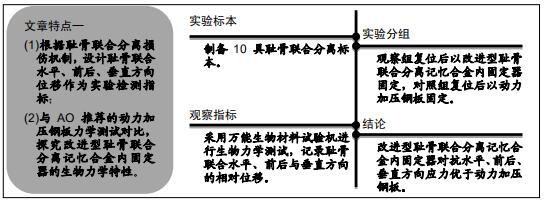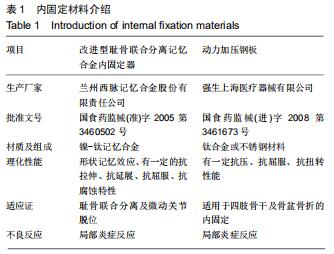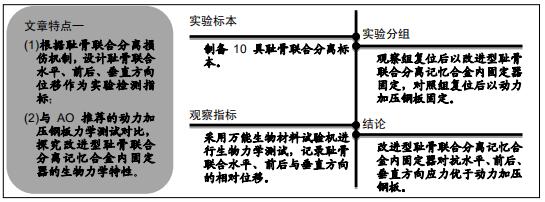|
[1] 董伟,田大为.鹿瓜多肽联合记忆合金内固定器治疗管状骨骨折的疗效观察[J].浙江临床医学,2015,17(7):1119-1120.
[2] 孙强,鲁尧,王洪勋,等.改良记忆合金环抱器治疗髋关节置换术后股骨假体周围骨折的生物力学研究[J].中华创伤杂志,2015,31(7):637-640.
[3] HIROHATA T, MIYAWAKI S, MIZUTANI A, et al.Subarachnoid hemorrhage secondary to a ruptured middle cerebral aneurysm in a patient with osteogenesis imperfecta:a case report.BMC Neurol. 2014;14(1):150-151.
[4] 李亮,徐永清,何晓清,等.三种内固定器械固定中足损伤的生物力学比较[J].中国临床解剖学杂志,2019,37(2):179-184.
[5] 李斯铭,王冬梅,曲爱丽,等.钉棒内固定TileB2型骨盆骨折的生物力学效果[J].医用生物力学,2016,31(3):240-245.
[6] 雷建银,刘海波,王志华,等.站立位下骨盆与骨折内固定稳定性分析[J].医用生物力学,2014,29(6):517-522.
[7] 薛兆龙,孟艳丽,王勤业,等.新型内固定器固定肱骨大结节骨折的生物力学研究[J].实用骨科杂志,2018,24(3):234-238.
[8] MAZZIOTTI G, MORMANDO M, CRISTIANO A, et al. Association betweenl-thyroxine treatment,GH deficiency,and radiological vertebral fractures in patients with adult-onset hypopituitarism.Eur J Endocrinol. 2014;70(6):893-899.
[9] SAGI HC, ORDWAY NR. DIPASQUALE T. Biomechanical analysis of fixation for vertically unstable sacroiliac disloca-tions with iliosacral screws and symphyseal plating.J Orthop Trauma.2004;18(3):138-143.
[10] 张伟,孙玉强,张长青.主译.骨盆与髋臼骨折治疗原则与技术[M].4版.上海:上海科技出版社2016:19-39.
[11] 项舟,魏代清,刘明,等.计算机辅助导航髋关节周围骨折及骨盆前后环骨折微创固定[J].中国修复重建外科杂志,2015,29(1):10-13.
[12] BOMBACI H. Outcome of internal fixation and corticocan⁃cellous grafting of symphysis pubis diastasis which developed after malunion of pubic rami fracture.Hip Pelvis.2017;29(2):150-153.
[13] YU KH, HONG JJ, GUO XS, et al.Comparison of recon-struction plate screw fixation and percutaneous cannulated screw fixation in treatment of Tile B1 type pubic symphy⁃sis diastasis:a finite element analysis and 10-year clinical experience.J Orthop Surg Res. 2015; 10(1):151.
[14] 郎毅,融恺,陈平波,等.内固定与外固定材料修复骨盆骨折损伤:合理选择与生物相容性[J].中国组织工程研究,2016,20(31):4700-4706.
[15] 刘国雄,肖柳斌,李鹏飞,等.内、外固定与保守方法治疗不稳定型骨盆骨折:骨痂生长及骨折愈合率比较[J].中国组织工程研究,2015,19(35): 5646-5651.
[16] CARMACK DB, MOED BR, MC CARROLL K, et al.Accuracy of detecting screw penetration of the acetabulum with intraoperative fluoroscopy andcomputed tomography.J Bone Joint Surg Am. 2001; 83(9):1370-1375.
[17] 刘华水,段升军,贾逢爽,等.TiRobot机器人辅助经皮空心螺钉内固定治疗不稳定型骨盆骨折[J].山东大学学报(医学版),2017,55(7):103-109.
[18] HOON QJ, PELLETIER MH, CHRISTOU C, et al. Biomechanical evaluation of shape-memory alloy staples for internal fixation-anin vitro study.J Exp Orthop.2016;3(1):19.
[19] BYUN T, BAE TS, KIM KH, et al.Analysis on biomechanical characteristics of shape memory alloy fixatiom grip for femoral fractures.Green Smart Technol.2016;141:19-26.
[20] 易新,宋西正.腰骶椎带锁轴向融合内固定器的有限元分析[J].中国组织工程研究,2018,22(31):4982-4986.
[21] SCHULZE C, WEINMANN M, SCHWEIGEL C, et al.Mechanical properties of a newly additive manufractured implant material based on Ti-42Nb.Materials(Basel).2018;11(1):E124.
[22] LIN X, XIAO X, WANG Y, et al.Biocompatibility of bespoke 3D-printed titanium alloy plates for treating acetabular fractures.Biomed Res Int. 2018;2018:2053486.
|


